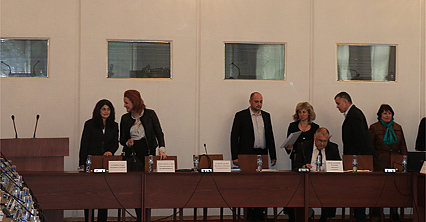News
National Program needed to curb osteoporosis in Bulgaria for another five-year period, says Health Committee Chair Dr. Nigyar Dzhafer
10/04/2014
 A National Program to reduce osteoporosis in Bulgaria for another five-year period is needed in order to achieve real results in the prevention of osteoporosis and complications of this disease. This was stated by the Chairperson of the Health Committee of the 42nd National Assembly Dr. Nigyar Dzhafer at the opening of a round table discussion "National Program for prevention of fractures in osteoporosis". The forum, held under the patronage of the parliamentary Health Committee, was organized on April 10, 2014 by the Bulgarian Medical Society of Osteoporosis and Osteoarthritis.
A National Program to reduce osteoporosis in Bulgaria for another five-year period is needed in order to achieve real results in the prevention of osteoporosis and complications of this disease. This was stated by the Chairperson of the Health Committee of the 42nd National Assembly Dr. Nigyar Dzhafer at the opening of a round table discussion "National Program for prevention of fractures in osteoporosis". The forum, held under the patronage of the parliamentary Health Committee, was organized on April 10, 2014 by the Bulgarian Medical Society of Osteoporosis and Osteoarthritis.The Health Committee Chair stressed that a multidisciplinary approach is needed for effective prevention of osteoporosis and prevention of complications of this disease. According to Dr. Nigyar Dzhafer, an integral part of the overall policy on the disease should be the adequate funding of affordable and modern treatment of osteoporosis, taking into account the real needs of patients based on the principles of efficiency and predictability of medication therapy.
Deputy Minister of Health Prof. Chavdar Slavov said that in 2000 the World Health Organization has defined osteoporosis as the third strong socially significant disease in the world - after cardiovascular and oncological diseases. The outlook back then was that by 2020 it will take the second place and today the statistics already show that osteoporosis has overtaken cancer.
Alarming data from various European countries were presented at the forum, according to which only 15-20 percent of women with osteoporosis receive adequate treatment. In Bulgaria this percentage is even lower - 3-4 percent. Experts explained that the low percentage of treated Bulgarians with osteoporosis is due to the low level of medicine reimbursement for this disease. During the period June 2009 - February 2010 14,232 patients received treatment from osteoporosis at 50 percent reimbursement of medicinal products, whereas over the same period a year earlier 23 percent fewer patients were treated at 25 percent reimbursement.
Endocrinologist of "Alexandrovska" University Hospital Dr. Natalia Temelkova noted that worldwide approximately one of every three women aged over 50 has osteoporosis. Broken femoral neck as a result of the disease has most dramatic consequences as 20% of patients die within six months due to immobilization and development of pneumonia, she said.
Dr. Plamen Popivanov of "Alexandrovska" University Hospital pointed out that the annual direct costs of osteoporosis in Bulgaria amount to BGN 44 million public and over BGN 19 million private funds, but the indirect costs of lost benefits, social assistance, disability, insurance, compensation for sickness etc. are much larger. Out of 426,000 Bulgarians with osteoporosis only 13,813 are treated. The funds allocated by NHIF for direct costs for osteoporotic fractures amount to BGN 32 million and for medical treatment and prevention of fractures – to BGN 1.1 million, added Dr. Popivanov.
The President of the Bulgarian Medical Society of Osteoporosis and Osteoarthritis Prof. Zlatimir Kolarov stressed that left untreated osteoporosis causes fractures, adding that every 30 seconds someone in the world gets a fracture as a result of the disease. Avoiding complications requires an individual approach to the patient to ensure adherence to treatment, good nutrition and exercise routine; study of bone mineral density in every 12 months, testing of bone turnover markers in every 3-6 months, and choice of appropriate anti-osteoporosis treatment and patient’s adherence to it, he said.

Latest news
- 22/04/2021
The Parliament imposed a moratorium on concessions, real estate deals and appointments pending the election of a new cabinet or caretaker government - 16/04/2021
By 156 votes “in favour”, the National Assembly accepted the resignation of the Council of Ministers with Prime Minister Boyko Borisov - 15/04/2021
Speech by Mrs. Iva Miteva upon her election as a President of the 45th National Assembly - 15/04/2021
The Member of Parliament Iva Miteva was elected President of the 45th National Assembly - 15/04/2021
The Members of the 45th National Assembly were officially sworn in - 03/03/2021
The President of the National Assembly Tsveta Karayancheva and MPs attended the solemn fireworks-retreat on the occasion of the Liberation of Bulgaria - 03/03/2021
Every Bulgarian should preserve and honour the memory of those glorious ancestors, thanks to whom Bulgaria exists today, said the President of the National Assembly Tsveta Karayancheva in Gabrovo - 03/03/2021
Today we are on Shipka to pay our respects to all the heroes who sacrificed their lives for freedom, said the President of the National Assembly Tsveta Karayancheva after climbing Shipka Peak together with young people from all over the country - 02/03/2021
The Vice-President of the National Assembly Valeri Simeonov received an award from the Bulgarian Republican Self-Government in Hungary - 26/02/2021
The Parliament adopted at second reading amendments to the Measures Against Money Laundering Act
 Български
Български English
English